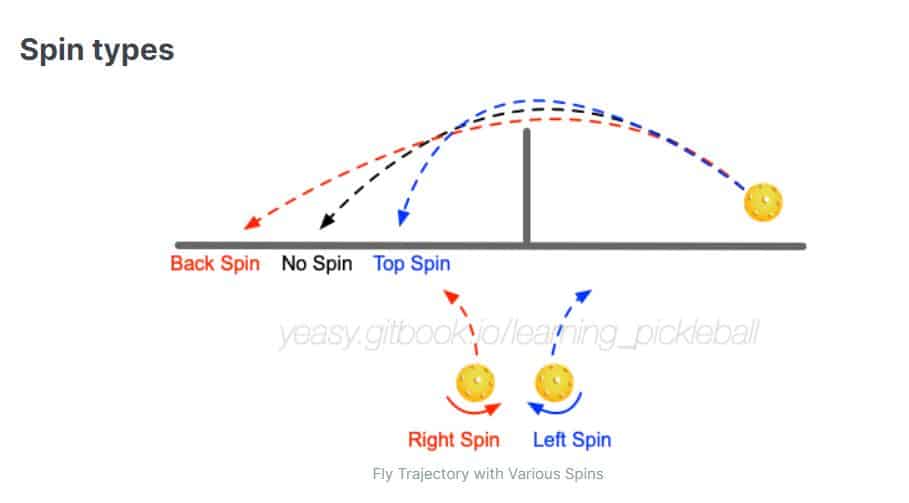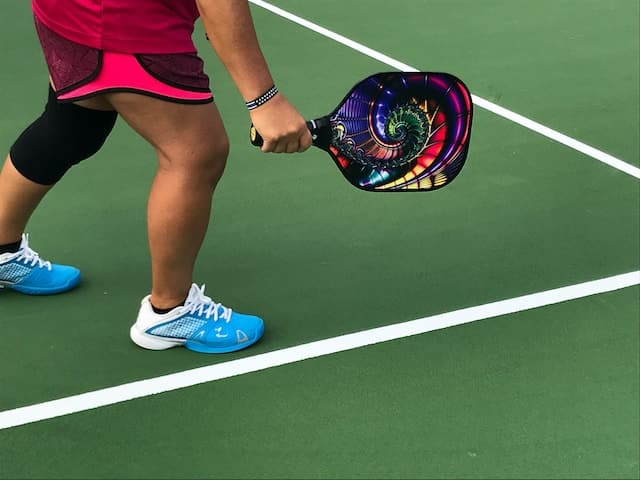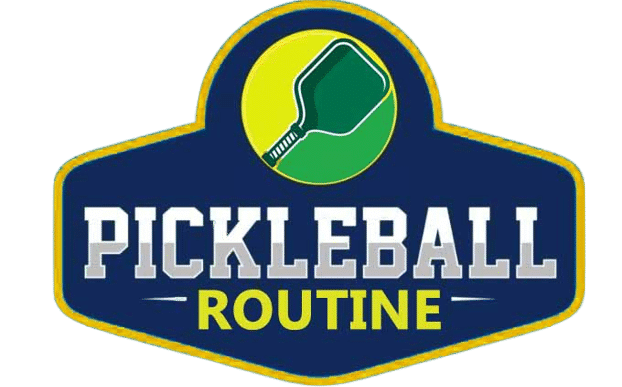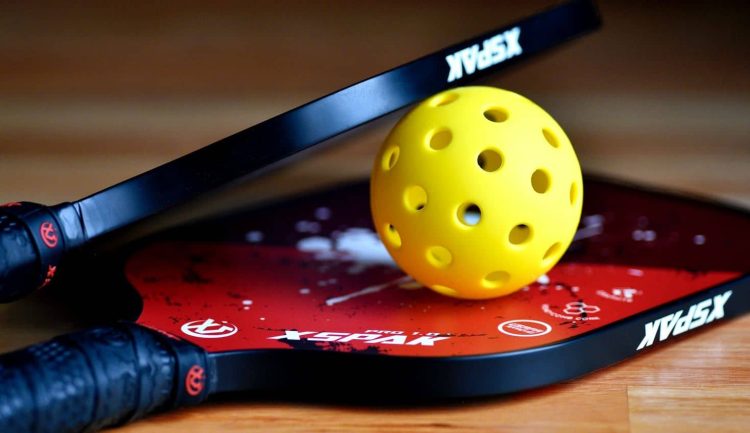Pickleball may look simple at first glance, but once players discover spin, the game takes on a whole new depth. Spin isn’t just about making the ball curve; it’s about controlling how it travels through the air and how it bounces off the court.
With the right touch, a shot can skid low, jump unexpectedly, or drop sharply at your opponent’s feet. Learning to generate and read spin turns rallies into strategic battles, where every stroke has the potential to shift momentum.
How to spin in Pickleball?
To make a pickleball spin, you’re really just teaching the paddle to brush the ball rather than slap it flat. Here are the most important steps boiled down into practical moves:
Grip with control, not tension
Hold the paddle firmly but not in a death grip. A relaxed wrist allows you to add finesse and brush the ball’s surface instead of just blocking it.
Brush, don’t smack
Spin comes from friction. Instead of hitting the ball square-on, angle your paddle slightly and brush across the ball—upward, downward, or sideways depending on the type of spin.
Use your wrist and forearm
A flick of the wrist or a pronation/supination of the forearm adds the fine touch needed for topspin, backspin, or sidespin. Think of painting a line with the paddle rather than hammering a nail.
Shape your paddle angle
Setting the paddle angle results in different types of spin discussed below.
- For topspin, brush up the back of the ball with a slightly closed paddle face.
- For backspin/slice, brush downward with an open face.
- For sidespin, cut across the side of the ball with the paddle tilted accordingly.
Follow through deliberately
Your follow-through direction influences how heavy and consistent the spin is. A smooth follow-through keeps the ball controlled, while an abrupt stop can cause inconsistency.
Position your body
Step into the shot and align your paddle path with your intended spin. Proper footwork makes it easier to brush consistently and with power.
Practice with purpose
Spin isn’t about raw strength—it’s about touch and repeatable mechanics. Drilling spins at slower speeds builds muscle memory before you add pace.
What factors influence the spin in Pickleball?
The factors that influence the spin in Pickleball are mentioned below.
- Paddle’s width
- Your standing position
- The angle at which you strike the ball
- When your paddle and the ball make contact
The manner in which a pickleball paddle influences ball spin is noteworthy. When you strike the ball with the paddle’s surface, the texture and composition of the paddle can substantially impact the amount and type of spin you can impart on the ball.
Pickleball paddles vary in terms of their surface materials and construction. Some paddles have a rougher surface texture, while others are smoother. The rougher surface can grip the ball better, allowing you to generate more spin by creating friction as the paddle contacts the ball.
Conversely, a smoother surface might offer less grip and result in comparatively less spin. Moreover, the paddle’s shape and design also play a role.
Paddles with a wider hitting area can potentially offer more control over the direction and angle of the spin, enhancing your ability to maneuver the ball precisely.
Additionally, the weight and balance of the paddle can influence how effectively you can execute spin techniques. A well-balanced paddle can aid in wrist movement and generate spin more naturally.
When working on your spin technique, it’s important to ensure that your paddle’s movement is in sync with the ball. When your paddle and the ball aren’t aligned correctly, your shots might end up off-target, requiring your opponent to put in extra effort to return the ball.
This insight is widely recognized among tennis players, who often incorporate spin into their shots. If you transition your pickleball paddle from a low position to a higher one while hitting the ball, you’ll naturally add topspin.
This technique proves beneficial when executing a lob, aiming to place the ball deep into the court or just inside the baseline. Similarly, utilizing spin during your serve can lead to a forceful bounce that challenges your opponent.

1- Choose the Right Grip
The most widely used grip in pickleball is called the continental grip. To determine the ideal size of paddle grip for yourself, you can refer to a resource that provides detailed information on this topic. Mastering a neutral grip, known as the continental grip, is essential.
To adopt this grip, it’s necessary to balance your hand placement on both the forehand and backhand sides of the paddle. Visualize this grip as the same as when you’re shaking hands with someone.
While it’s not an overly forceful grip for forehand shots, it’s also not a weak one. It lies right in the middle, being neutral. The same principle applies to the grip you use for backhand shots.
Using this grip offers several advantages: it enhances your reaction speed and facilitates quicker exchanges, especially at the kitchen line. Additionally, employing a continental grip keeps the face of your paddle open, leading to increased ball spin.
When generating spin, it’s crucial for the movement to appear natural. Avoid employing a jerky or unnatural motion, as it can negatively impact your shots. Such exaggerated movements often result in the ball hitting the net or soaring too high, making it easier for your opponent to take control.
2- Set the Flow
You might come across as someone who used to play racquetball and has now embraced pickleball.
Due to your previous experience in racquet sports, you could be inclined to rely on excessive wrist movement, resulting in a peculiar side spin that causes unpredictable rebounds.
This tendency could contribute to missing services frequently. As a result, it’s important to adopt a more fluid approach when generating spin in pickleball.
3- Contact with Pickleball
It’s crucial to bear in mind that the pickleball ball differs from a racquetball in terms of weight, leading to distinct physics at play. Consequently, when you execute a shot, there’s a specific aspect you should focus on, something within your control.
By honing your grasp of the game’s fundamentals and mastering the art of delivering a well-executed shot, you’ll naturally incorporate a spin into the ball’s trajectory.
The essential strategy lies in achieving a strong connection with the ball by adhering to the foundational techniques. This approach will effortlessly introduce spin into your shots, almost without you realizing it.
4- Positioning
Generating the correct type of spin requires proper handling of your paddle. Start by positioning yourself with your feet at shoulder-width apart and your toes angled around 60 degrees, facing each other.

Hold the paddle with both hands, clasping the grip while ensuring your thumbs point toward each other.
Pay attention to your paddle’s alignment and your arm’s posture during your backswing. Position the paddle so it travels above your shoulder, avoiding overextension of your arm to prevent potential injuries.
Equally important is mastering your stance, as maintaining a solid posture contributes to balance and control throughout your paddle swings. Aim to evenly distribute your weight over your feet, maintaining a shoulder-width stance.
Maintain an upright torso while keeping your elbows slightly bent (but not rigid). Adhering to this approach will enhance your paddle swings by granting you better accuracy and power.
5- Backswing
When crafting a swing in pickleball to generate spin, it’s helpful to approach it similarly to a tennis stroke, emphasizing a complete follow-through.
Begin by rotating your wrist backward and then swiftly snapping it forward. Simultaneously, move the paddle’s head backward while curving it downward.
As you connect with the ball, ensure the paddle’s head is parallel to the ground, adjusting the angle slightly as you swing it back. Upon contact with the ball, subtly pull the paddle’s head backward.
This motion induces spin on the paddle’s head and enhances your perspective for hitting the ball accurately.
Continuing the motion of your swing involves maintaining the paddle behind the ball, which aids in preventing a weakened shot. Always position the paddle ahead of you, with the forehand side facing the net. This positioning guarantees a favorable angle for hitting the ball effectively.
When to Spin in Pickleball?
Knowing when to incorporate spin into your shots can greatly enhance your gameplay. Here are situations where utilizing spin can prove advantageous:
- Serve: Apply spin to confound your opponent’s prediction of the ball’s path.
- Dink or Drop Shots: Employ spin to force your opponent into uncomfortable positions, resulting in returns that are either too high or too low.
- Drive or Lob: Utilize topspin to prevent the ball from going out of bounds.
- Volley: Introduce spins to disrupt your opponent’s ability to counter your shot effectively.
- Around-The-Post (ATP) Shot: Employ side spin to allow the ball to land within the court from an outer position.
How to handle spinning balls?
Effectively managing spinning balls necessitates a comprehensive understanding of how various spins influence the ball’s trajectory and post-landing behavior. This knowledge allows you to anticipate and respond adeptly for solid returns.
For instance, when faced with an opponent’s topspin shot, adjust your position slightly forward and ensure your paddle surface isn’t overly elevated. Alternatively, you can proactively utilize the incoming topspin’s force to your advantage in your shot.
To counteract spin’s influence, the fundamental strategy involves mirroring the technique used by the player who initiated the spin.
For instance, countering backspin involves hitting the ball’s bottom, while facing topspin, aiming to lift the ball avoid it dropping too close to the net.
When countering backspin with a drive, emphasize an upward motion more than when returning a non-spinning ball.
Lastly, executing faster shots can limit the contact time between the ball and the paddle, consequently diminishing the spin’s impact. This approach reduces the opportunity for spin to take full effect and enhances your ability to manage the ball’s behavior effectively.

It’s me Joe, a devoted pickleball enthusiast, and an avid player, I’m passionate about sharing the joy and excitement of the game through my Pickle Ball Routine. With years of experience on the court, I have honed my skills, explored various strategies, and developed a deep understanding of the nuances of pickleball.
I believe in the power of community and the incredible connections that can be forged through pickleball. I have had the privilege of engaging with players of all levels, from beginners seeking guidance to seasoned athletes looking to enhance their gameplay. My friendly and approachable demeanor makes me a valuable resource for players of all backgrounds.
Through Pickle Ball Routine, I aim to inspire and educate fellow pickleball enthusiasts. By sharing personal experiences, tips, techniques, and stories from the game, I strive to create a platform that fosters growth, camaraderie, and an unyielding passion for pickleball.

